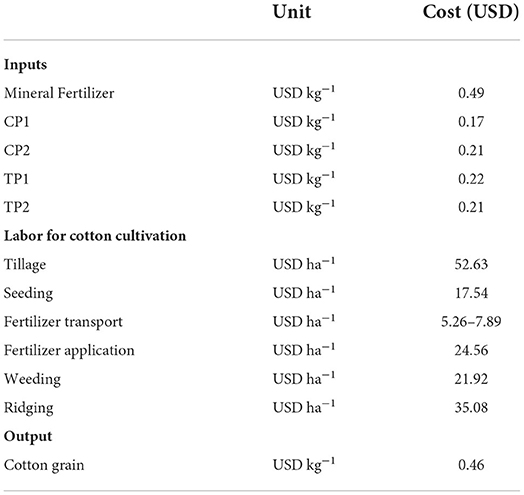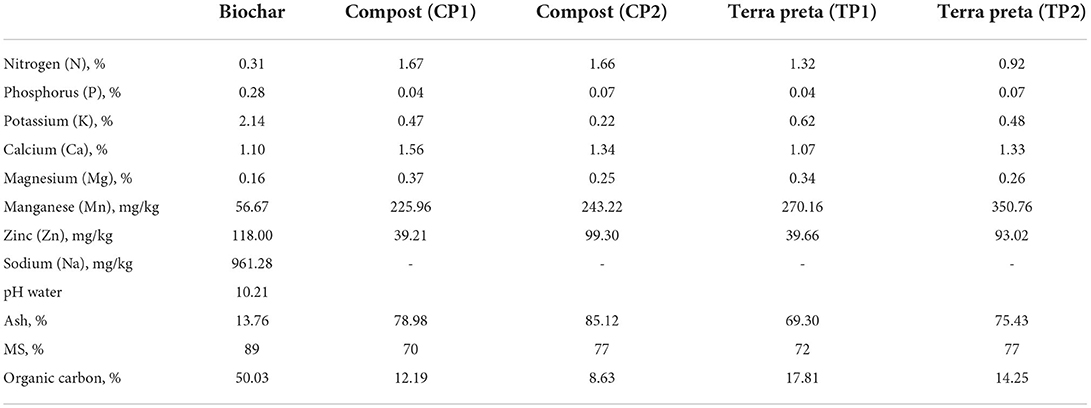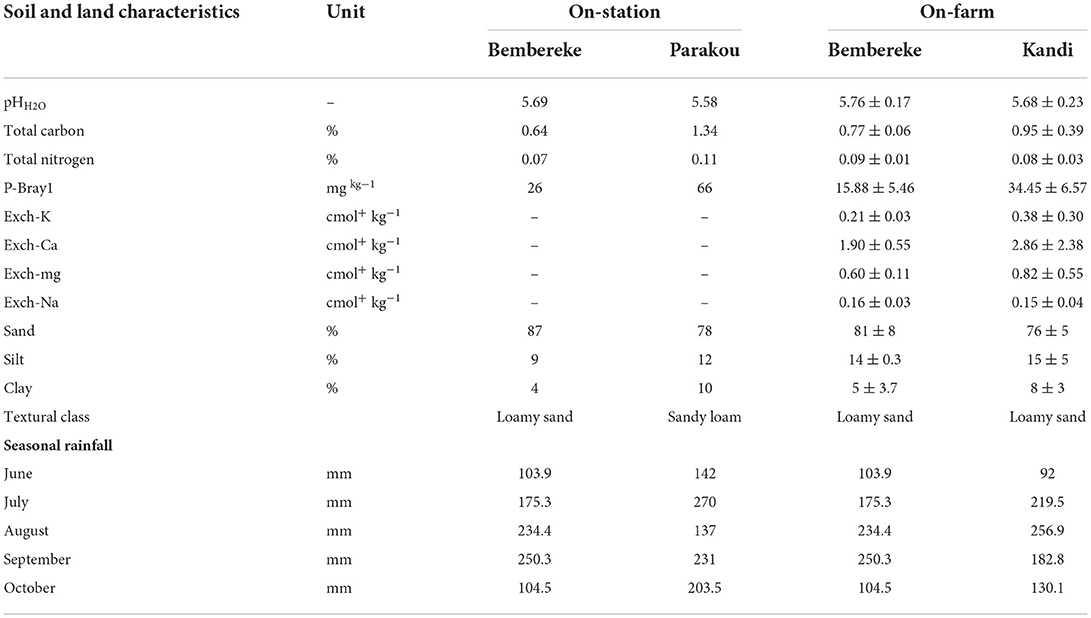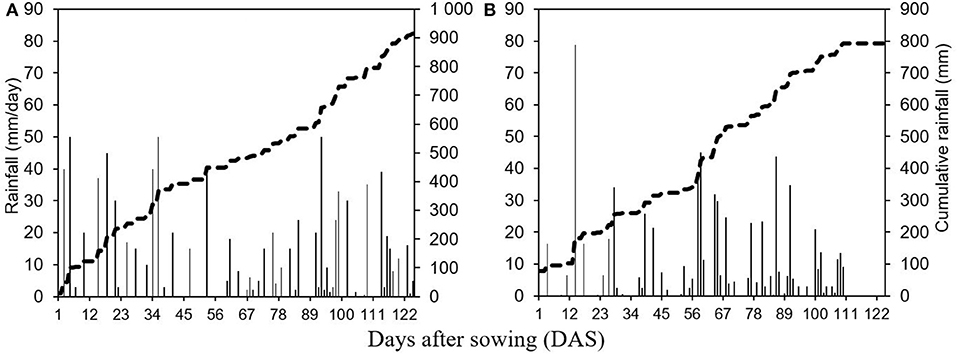- 1Faculty of Agronomy (UP/FA), Laboratory of Hydraulics and Environmental Modeling (HydroModE-Lab), University of Parakou, Parakou, Benin
- 2Faculty of Agronomy (UP/FA), Integrated Production Systems Innovation Lab & Sustainable Land Management (InSPIREs-SLM), University of Parakou, Parakou, Benin
- 3Faculté d'Agronomie, Département des Sciences et Techniques de Production Végétale (D/STPV), Université de Parakou, Parakou, Benin
- 4Protection et Réhabilitation des Sols pour améliorer la Sécurité Alimentaire (ProSOL-GIZ), Cotonou, Benin
- 5Protection et Réhabilitation des Sols pour améliorer la Sécurité Alimentaire (ProSOL)/Deutsche Gesellschaft für Internationale Zusammenarbeit (GIZ), Cotonou, Benin
Low land productivity is a major constraint facing agriculture in sub-Saharan Africa, which severely affects crop yields, particularly cotton which is main export agricultural produce of Northern Benin. To overcome this situation, the hill-placement of microdose biochar-compost-based amendments was carried out at two research stations and on farmer's fields in three agroecological zones of northern Benin. The study aims to evaluate the agronomic and economic performance of cotton under two types of compost and biochar-based amendments. On stations, the experimental design used was a complete randomized block with one factor and ten treatments replicated four times as follows: (i) absolute control without any amendment (Ck), (ii) mineral fertilizer (MF) at 200 kg/ha, (iii) cow dung-based compost at 200kg/ha (CP1_200) and (iv) 300kg (CP1_300), (v) household waste-based compost at 200kg/ha (CP2_200) and (vi) 300 kg (CP2_300), the combination of CP1 and 15% biochar designated Terra preta (TP) applied at 200kg/ha (vii, TP1_200) and 300kg/ha (viii, TP1_300), the combination of CP2 and 15% biochar applied at 200kg/ha (ix, TP2_200) and 300kg/ha (x, TP2_300). On-farms, the experimental design was a randomized complete block with one factor and six optimal treatments extracted from the on-station experiments with three replicates installed in four farmers' fields from each location studied. The six treatments were: Ck, MF, CP1_200, CP2_200, TP1_200 and TP2_200. Cotton growth (Plant height, number of vegetative and reproductive branches and total bolls per plant) and yield data were collected. The treatment TP1_300 yielded higher cotton seed with 2.53 t/ha, i.e., 86% more than the absolute control. However, the highest plant growth parameters were obtained with MF which were similar to those obtained with TP1_300 (P > 0.05). Likewise, at farms, the highest plant growth parameters and yield were observed with MF followed by TP1_200 (with a cotton seed yield increase of 146% compared to the control, P < 0.05). In addition, no significant differences were observed between organic fertilizers treatments for growth variables. However yield differences occurred. To resume, TP1_300 kg/ha performed best in terms of growth and yield in on-station experiments, while on-farms, TP1_200 kg/ha produced the highest responses of cotton. Value Cost Ratio (VCR) and Benefit Cost Ratio (BCR) values were generally as good or even better for MF treatment and treatments involving CP1 at both on station and on farm, compared to Ck. Although applying mineral fertilizer (MF) alone as currently done by many farmers appears to make economic sense, this practice is unlikely to be sustainable in the long term. Applying TP1_200 and TP1_300 are two possible strategies that are affordable to farmers and provide returns on investment at least as good as the current practice of sole application of MF. However, a long-term study to assess the effect of compost-activated biochar on crop productivity and soil quality is advised.
Introduction
Cotton (Gossypium hirsutum L.), has been for years a lever for transformation in agricultural production systems. However, its production plays an important role in the economy of West and Central Africa (Soumaré et al., 2021). It represents nearly 30% of exports and contributes, in terms of value added to 7% Gross Domestic Product (World Bank, 2016). Despite this importance, cotton production is characterized by low productivity due to low inherent soil fertility coupled with poor agricultural practices including excessive use of mineral fertilizers (Amanet et al., 2019). The latter can contributes to long-term soil acidification (Adams et al., 2016) and a decrease in organic matter (Bationo et al., 2012; Vanlauwe et al., 2014). In addition, temperature variation and the uncertainty of rainfall patterns strongly affect the crop productivity (Rosenzweig et al., 2014; Ahmad et al., 2018; Nasim et al., 2018).
Improving soil fertility has become a mandatory step for the sustainability and productivity of production systems in West Africa savannas (Bationo et al., 2007; Koulibaly et al., 2015). However, this improvement requires the integration of sustainable land management (SLM) measures whereby bringing organic matter to the soil will lead to an increase in the carbon stock whose depletion leads to soil degradation (Lal, 2009).
Several techniques for the sustainable management of soil fertility have been tested by researchers both around the world and in sub-Sahara Africa. These practices involve the use of different forms of organic amendments viz. compost, manure, crop residues, green manure, fertilizer microdosing, etc. to improve the physical, chemical and biological properties of the soil (Akponikpe et al., 2008; Ibrahim et al., 2015; Agegnehu et al., 2016; Tovihoudji et al., 2017, 2019). Compost is an excellent fertilizer for plants because of its beneficial effects for nutrients supply to the soil including nitrogen, phosphorus, potassium and various other micronutrients (Nacro et al., 2010). It is therefore urgent to find a sustainable alternative to conventional agricultural land management by taking inspiration from traditional practices, reproducing and amplifying what nature achieves (Montaigne et al., 2018) to improve soil pH and nutrient bioavailability. In the context of global challenges (climate, input price variability, market access), meeting these expectations requires the development of sustainable and resilient land management practices from organic waste. In peasant environments, there is a wide diversity of organic substrates available for use by farmers (Blanchard et al., 2014). These include cattle, sheep, goat and poultry droppings, household wastes, and biochar from the pyrolysis of maize cobs or stalks or rice husks (green charcoal).
Biochar, “green charcoal”, is the result of the slow pyrolysis of plant biomass in an oxygen-free or low-oxygen atmosphere. The result is a product with a very high carbon content (Rutigliano et al., 2014). The scientific literature on the effects of biochar is very prolific on food crops (Cornelissen et al., 2013; Nyami et al., 2016; Yeboah et al., 2016; Jeffery et al., 2017; Steiner et al., 2018; Chen et al., 2022). One of the promising technologies to improve the pH and bioavailability of soil nutrients is the combined use of biochar and organic or mineral fertilizer. Biochar generally has a positive effect on crop yields when applied effectively to soils that are not very fertile, moderately fertile or degraded than to healthy fertile soil (El-Naggar et al., 2019). Several authors have shown that integrating biochar into highly eroded or erodable tropical soils significantly improves their physical, chemical and biological properties and crop yields (Cornelissen et al., 2013; Nyami et al., 2016; Yeboah et al., 2016; Jeffery et al., 2017; Steiner et al., 2018; Chen et al., 2022) in vegetable and cereal crops but very little information is known on the effect of biochar from maize cobs on cotton performance (Elangovan and Sekaran, 2014).
In the dynamics of ecological transition and with a view of providing the ever-growing population with quality and healthy agricultural products, the reduction of chemical inputs in favor of renewable inputs such as biochar-compost-based amendment (known as “Terra preta”; Lehmann, 2009) is a path that should be preferred. The present study aims to evaluate the effects of two biochar-compost-based amendments on the agronomic performance of cotton and economic feasibility in on-station and on-farm environments from three agro-ecological zones of northern Benin.
Materials and methods
Study sites
Two on-station experiments were carried in Northern Benin in the municipality of Parakou at the experimental station of Faculty of Agronomy/University of Parakou (9°18'04”N and 2°42'37”E) and in the municipality of Bembereke at the Agricultural Research Center of Northern Benin (9° 57′30”N and 2°43′39”E). The sites were located at agro-ecological zone III, Bembereke and agro-ecological zone V, Parakou). Two additional experiments were carried out on farmers' fields at Bembereke (village of Ina Gando, agro-ecological zone III; between 9°58'14” and 9°58'32”N and between 2°43'22” and 2°44'06”E) and Kandi (village of Padé, agro-ecological zone II, between 11°02'16” and 11°02'28”N and between 2°53'44” and 2°52'56”E). The sites (both on ation and on farm) were located in the Sudano-Savanna area of northern Benin (West Africa, Figure 1) with tropical climate characterized by a rainy season from May to October and a dry season from November to April. The average annual precipitations were 1,200, 1,070, and 1,000 mm in Parakou, Bembereke and Kandi, respectively. The soils in Parakou are of light texture and significant thickness due to the weakness of erosion. In Bembereke and Kandi, the soils are of tropical ferruginous type. These are soils with a more or less important depth and good permeability and porosity (Igué et al., 2017).
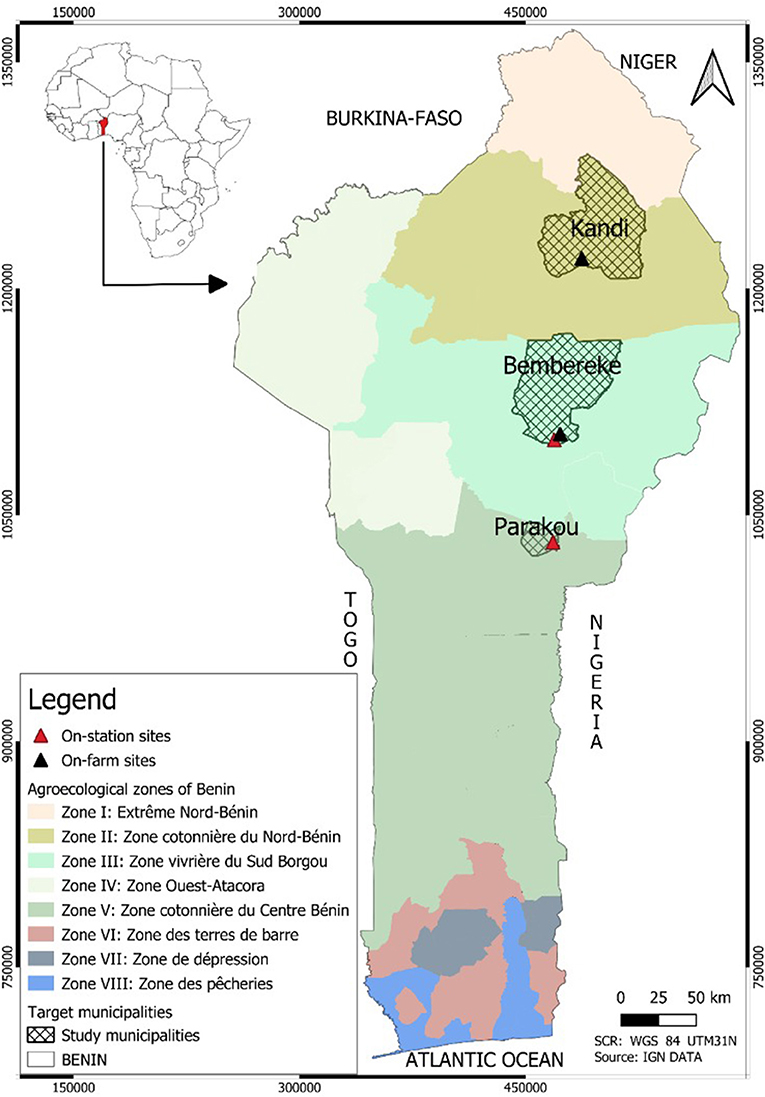
Figure 1. Map of Benin showing the location of the three sites (Parakou, Bembereke and Kandi) in Northern Benin.
Experimental design, treatments and crop/soil management
For the on-station trials, the experimental design was a complete randomized block with ten (10) treatments and four replicates. The ten treatments were: (i) absolute control with no amendment (Ck), (ii) mineral fertilizer (MF) at 200 kg/ha, (iii) cow dung-based compost at 200kg/ha (CP1_200) and (iv) 300kg (CP1_300), (v) household waste-based compost at 200kg/ha (CP2_200) and (vi) 300kg (CP2_300), the combination of CP1 and 15%biochar designated Terra preta (TP) at 200kg/ha (vii, TP1_200) and at 300kg/ha (viii, TP1_300), the combination of CP2 and 15% biochar at 200kg/ha (ix, TP1_200) and 300kg/ha (x,TP1_300). The on-farm trials were conducted in two villages in the municipalities of Bembereke (village of Ina Gando) and Kandi (village of Padé) with four (04) farms per village. The experimental design was a randomized complete block with three replicates per farm with a total of 12 replicates per village. Each replicate consists of six (06) treatments selected from the 10 treatments tested in on-station trials namely: Ck, MF, CP1_200, CP2_200, TP1_200 and TP2_200.At both on-station and on-farm sites; each experimental plot (5 x 4 m) contained 6 separate lines with 80 cm row spacing and 40 cm spacing between plants. The blocks were separated by alleys of 3 m and the plots were separated by 2 m. Due to low application rates, and based on recent studies (Tovihoudji et al., 2017, 2019), the organic amendments were hill-placed to improve their effectiveness. The entire amount of compost and TP were applied after emergence (10–15 days after sowing, DAS). The mineral fertilizer was fractioned and spot-applied: 150 kg/ha of compound NPK at 10–15 DAS and 50 kg/ha of urea at 45 DAS. The cotton varieties recommended according to the agroecological zones were used: OKP 768 variety (150 maturity-days) in Parakou and Bemberekè and ANG 956 variety (150 maturity-days) in Kandi. Weeds were cleared by using a hand hoe at 14 and 45 DAS and the pesticide “Super Lambda” was sprayed 5-6 times to protect the cotton bolls against pests.
Participating farmers in the on-farm trials were identified by the agricultural advisors based on their experience in cotton production, their willingness and consent to participate in the trials. Farmers were trained before the start of the rainy season. They fully managed their experimentation, and the role of the researchers was limited to train them for application of amendments and monitoring management practices and also to data collection. Other crop management practices were left to each farmer. Organic and mineral fertilizers were applied in the same way as for the on-station trials.
Preparation of composts, biochar and Terra preta and their composition
CP1 compost was made by the Association des Femmes Vaillantes et Actives (AFVA) of Banikoara (northern Benin) by the windrow manufacturing method from dry cow dung, manure collected in stables, ash and rice straw. At maturity, CP1 compost was enriched with treated human urine. CP2 compost was made in piles (aerobic conditions) by the ReBin project from household organic waste in the municipality of Toffo (Southern Benin) and biogas digestates. The process took 3 months. Then, the compost was dried in shade, sieved and packaged in the bags of 50 kg.
Biochar was produced by slow pyrolysis using a metal drum kilns at a temperature of about 500 °C (Narzari et al., 2015; Steiner et al., 2018). Biochar was made from corn cobs. The biochar obtained after pyrolysis was crushed and powdered using a mill to ease the preparation of biochar-based-organic amendments.
Regarding the Terra preta, TP1 was produced by the AFVA. During the composting of CP1, at 2 months, the biochar was added to the windrows with 15% of biochar. The mixture lasted a month and was turned once a week to allow the nutrients to be loaded into the biochar. The biochar mixed with compost was sieved and then bagged into 50kg. TP2 was obtained from CP2. CP2 compost was purchased and mixed with biochar with 15% of biochar. An addition of water was regulary done and turned over every 4 days for 2 weeks.
In order to determine the chemical composition of the amendments, samples were collected, air-dried and oven-dried at 65°C to a constant mass before analysis. Each sample was a composite of ten to twelve subsamples. Subsamples of the dried materials were crushed for chemical analysis at the Laboratory of Soil, Water and Environmental Sciences (LSSEE/INRAB) at AgonkameyResearch Center, South Benin.
Sampling, measurements, and calculations
Initial soil analysis
Soil data were collected in both on-station and on-farm sites using the same methodology. At each site, samples were collected at a depth of 20 cm on the diagonal before the installation of the trials. After collection, the samples were carefully mixed to have a composite sample. The soil samples were spread, dried, crushed and sieved to 2 mm at the Soil, Water and Environmental Sciences Laboratory (LSSEE/INRAB) in Agonkanmey to determine particle size, organic carbon, total nitrogen, available phosphorus, exchangeable bases and cation exchange capacity. The particle size was determined by the Pipette Robinson method (AFNOR, 1987). Organic carbon was evaluated by the Walkley and Black (1934) method, total nitrogen was determined by the Kjeldahl method (Houba et al., 1995). Available phosphorus was determined by the Bray1 and Kurtz method (Van Reeuwijk, 1993), the cation exchange capacity by distillation and the exchangeable bases were determined by the Atomic Absorption Spectrophotometer after extraction with 1N ammonium acetate at pH by the method described by Van Reeuwijk (1993).
Yield and yield components
Plant height, number of vegetaive and reproductive branches and total bolls were recorded at boll opening stage on five plants randomly chosen per plot from each replicate. Cotton seed yield (kg/ha) was assessed two times by manually harvesting plants from each plot. The bolls were dried to ≤ 12% water content, ginned to determine cotton seed and lint yield. At the second harvest, one hundred (100) fully mature open bolls were hand-picked from each plot to determine single boll weight and ginning percentage. Lint percentage was calculated from the ratio of lint yield derived from 100 bolls and divided by seed cotton weight of 100 bolls.
Economic analysis
Economic profitability of the different treatments was analyzed based on gross return, gross margin, benefit/cost ratio (BCR) and value/cost ratio (VCR). Fixed costs included the cost of all major labor charges (field preparation, seeding, weeding and ridging) whereas variable costs included the cost of fertilizer and/or manure, cost of their transport and labor charges for the application of the fertilizer and/or manure (Table 1). The cotton seeds were not purchased because subsidized by the government through the “Société pour le Développement du Coton (SODECO). The prices of fertilizer fixed by SODECO were used. Labor costs for land preparation, sowing, fertilizer and/or manure application, weeding, and ridging were collected during the experiments through farm diaries. For the seed-cotton price, we used the average values of the two last seasons (265 FCFA kg−1) (1USD=656 FCFA). Total revenue was calculated by multiplying cotton grain yield with the grain unit price. The gross margin (GM) was calculated by subtracting variable costs from total revenue. The gross return (GR) was calculated by subtracting the sum of the fixed and variable costs from the revenue. The value cost ratio (VCR) was computed as the difference in grain yield between the fertilized plots and the control plot multiplied by the unit market price of grain, divided by the cost of applied fertilizer. According to Kihara et al. (2015), general rules have been established for interpreting VCR. A VCR < 1 indicates negative return on investment, a VCR = 1 entails positive return on investment bur not viable, whereas a VCR> or = 2 means positive return on investment that is economically viable.
Statistical analysis
Before analysis, the data were thoroughly cleaned. Then, the normal distribution and homogeneity of variances were checked with the Anderson-Darling and Levene's test, respectively. Regarding the on-station data, the effect of treatments and site-treatment interaction were examined using an analysis of variance (ANOVA 2) with Gensat v12 software. Because of the different varieties used in the on-farm trials, the statistical analyses were carried out for each site using a mixed linear model, considering treatments as a fixed factor and farms and replicates within farm as random factors. The test of Tukey was also used to compare means at 5%.
The stability of yields in relation to different environments was determined by the curve of the yield of treatments of a replicate as a function of the associated environmental yield (Guertal et al., 1994). The slope of the regression line was used to assess yield stability by treatment (smaller the slope, the greater is the yield stability; Guertal et al., 1994). The yield response of treatments relative to the control was calculated by subtracting the control yield from the treatment under consideration.
Results
Major characteristics of the amendments and experimental sites
Biochar had a pH of 10.21, with concentrations of 50.03% C, 0.31% total N, and 13.76% ash. The results of chemical analysis showed that the percentage of nitrogen of both types of compost is higher than the other organic amendments but low (0.31%) in the biochar. Unlike, the percentage of organic carbon is high (50.03%) in biochar and low in Toffo compost. By comparing the two Terra preta, it appears that the percentage of carbon contained in the Terra preta of banikoara (TP1) is higher (17.81%) than that contained in the Terra preta of toffo TP2) (Table 2). In addition, the percentage of phosphorus (0.28%) and potassium (2.14%) contained in the biochar is higher than the other treatments.
The texture of experimental soils at both on-station and on-farm sites varied from loamy sand to sandy loam. The nitrogen content of the sites where below 1% (Table 3). The soils were slightly acidic (pH = 5–6.6) both at on-station and on-farm sites. There was also a low level of total carbon. The values of available phosphorus were relatively high (Table 3).
A cumulative rainfall of 792.8 and 914.5 mm were recorded during the growing season in Bembereke and Parakou, respectively (Figure 2). In addition, the highest daily rainfall was recorded in the municipality of Parakou at 20 DAS (50 mm) which remains low compared to that recorded in Bembereke at 15 DAS (79 mm). Rainfall was well distributed in Parakou unlike Bembereke (Figure 2). Under on-farm experiments, Bembereke and Kandi received 868.4 mm and 881.3 mm of rain from June to October, respectively, with the highest amount of rain observed in August and September in Bemberekè and July and August in Kandi.
On-station trials
Growth parameters
The plant height was significantly affected by the different treatments at both sites (P < 0.001; Figure 3). The mineral fertilizer (MF) treatment produced the maximum height (132.85 cm). Among the organic treatments, the maximum height was obtained with TP1_200 (120.5 cm). There was a significant site by treatment interaction on plant height (P < 0.001). Indeed, for organic fertilizers, the average height values were higher in Parakou than in Bembereke for all treatments with a maximum height of 138.6 cm.
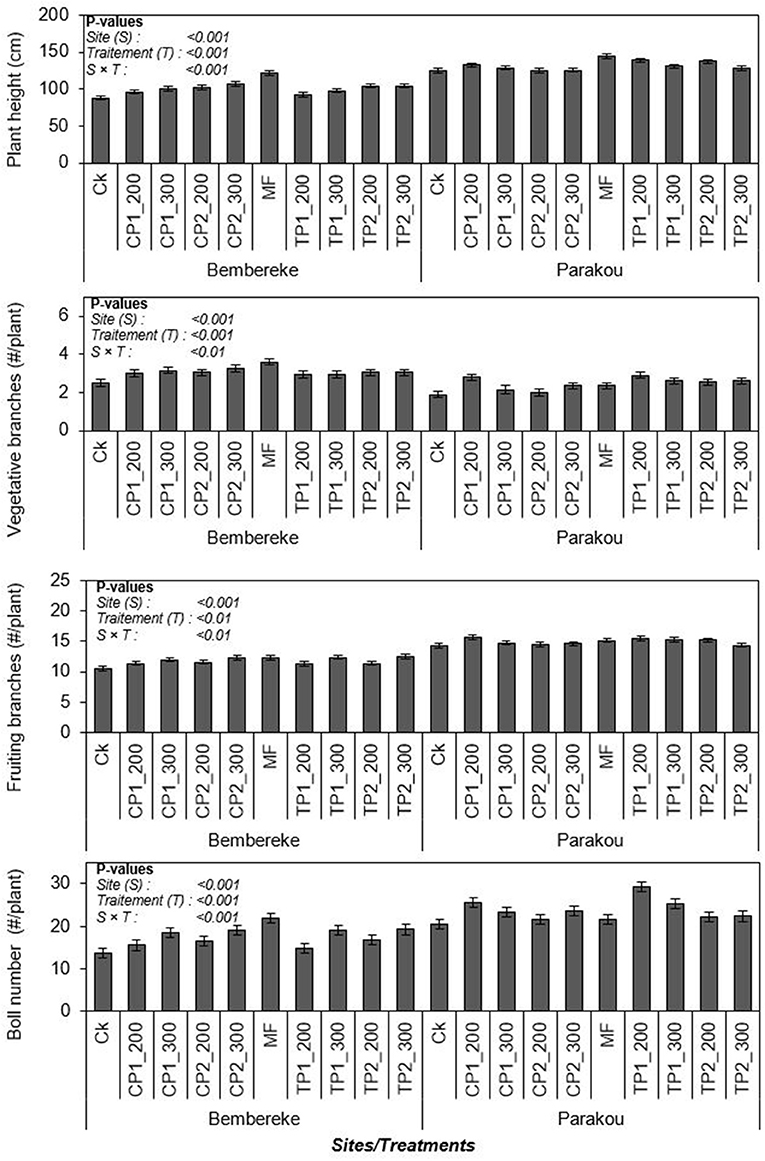
Figure 3. Site by treatment interaction effect on plant height, number of vegetative and fruiting branches, and number of bolls of cotton. Ck, control; MF, mineral fertilizer; CP1-200, Compost of Banikoara at 200 kg/ha; CP1-300, Compost of Banikoara at 300 kg/ha; CP2-200, Compost of Toffo at 200 kg/ha; CP2-300, Compost of Toffo at 300 kg/ha; TP1_200, Terra preta of Banikoara at 200 kg/ha; TP1_300, Terra preta of Banikoara at 300 kg/ha; TP2_200, Terra preta of Toffo at 200 kg/ha; TP2_300, Terra preta of Toffo at 300 kg/ha.
The number of vegetative branches was significantly affected by the sites and treatments (P < 0.001; Figure 3) with the largest number of vegetative branches recorded at Bembereke. Biochar-based fertilizers with compost at 200 kg/ha (TP2) recorded the largest number of vegetative branches compared to the control (2 branches). A significant site by treatment interaction was observed (P < 0.001). At Bembereke, the highest number of vegetative branches was observed in the MF treatment followed by CP2_300, while in Parakou it was observed in TP1_200 followed by CP1_200.
The number of fruiting branches was significantly affected by the sites and treatments (P < 0.001; Figure 3) with the highest number recorded in Parakou and underin CP1_200 (16 branches), TP1_300 (15 branches) and MF (15 branches) treatments. There was also a significant site by treatment interaction. CP1_200 produced the highest fruiting branches (16 branches) in Parakou while TP2_300 produced the highest fruiting branches (13 branches) in Bembereke.
The number of bolls per plant varied significantly between sites (P < 0.001; Figure 3) with the highest number recorded in Parakou. The number of bolls per plant were significantly affected by the treatments. At 120 DAS, the highest number of bolls per plant (22 bolls) were recorded in the TP1_300 and MF treatments. There was also a significant site by treatment interaction on the number of bolls per plant. In Parakou, the highest number of bolls per plant was recorded in TP1_200 (29 bolls) while the highest number of capsules per plant was determined with MF in Bembereke (22 bolls).
Yield and components
The seed-cotton and lint yields were not affected by sites but were significanlty affected by treatments (p < 0.05; Table 4). The MF treatment produced the highest yields in term of seed-cotton and lint (3.0 and 1.7 t/ha, respectively). Among the organic fertilizers, the TP1_300 treatment produced a similar seed and lint yields compared to the MF treatment with an 86 and 73% increase over the control, respectively. No site by treatment interaction was observed for the seed-cotton and lint yields (Table 4).
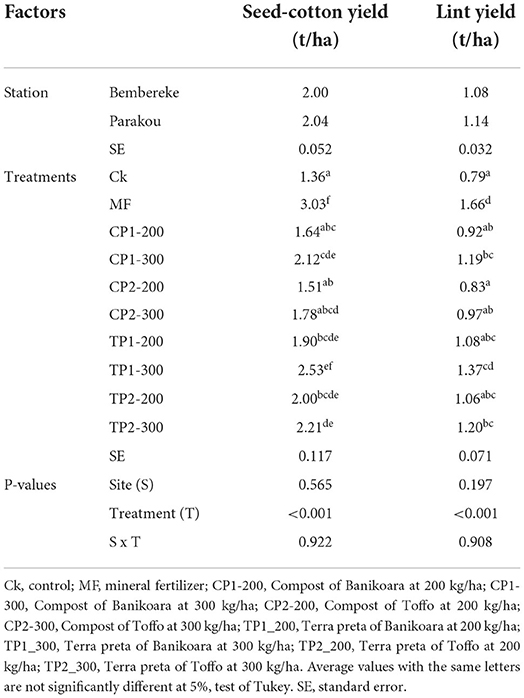
Table 4. Effect of different biochar-based amendments on seed-cotton and lint yields at the two on-station experimental sites in northern Benin.
Economic indicators
All the economics parameters were significanlty affected by the sites (p < 0.001; Table 5). The site of Parakou produced the highest values of net return (NT), gross margin (GM), BCR and VCR. NT, GM, BCR and VCR were also significanlty affected by treatments (p < 0.01; Table 5). The MF treatment produced the highest values for these economics parameters (683.4 USD/ha, 793.9 USD/ha, 3.1 and 4.4, respectively). Among the organic fertilizers, the TP1_300 treatment produced the highest values for NT, GM, BCR and VCR (513.7 USD, 624.3 USD, 2.6 and 3.4, respectively) similar to the values obtained with MF treatment. A significant interaction were observed between site and treatment for all economics parameters (p < 0.01; Table 5). The response to treatments was more pronounced in Parakou than in Bembereke.
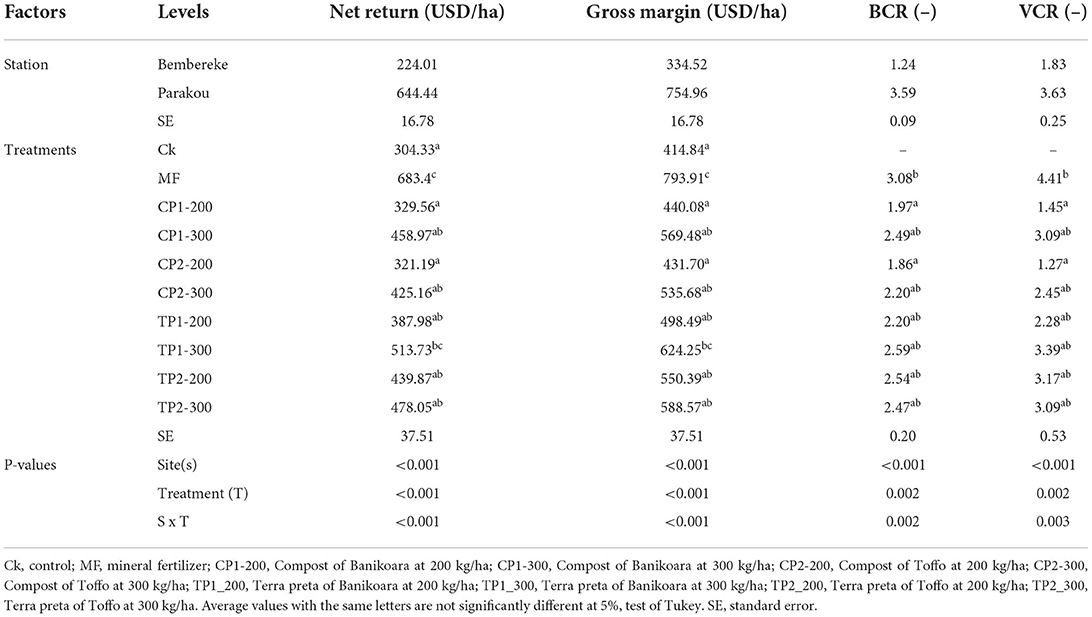
Table 5. Effect of different biochar-based amendments on economic indicators at the two on-station experimental sites in northern Benin.
On-farm trials
Yield and components
In the on-farm sites, seed-cotton and lint yields were significantly affected by the treatments at both study sites (P < 0.001; Table 6). At both sites, the TP1_200 produced good yield in term of seed-cotton and lint which was close to the MF treatment with an increase of 99 and 92% in seed-cotton yield compared to the control, in Bembereke and Kandi, respectively (Table 6).
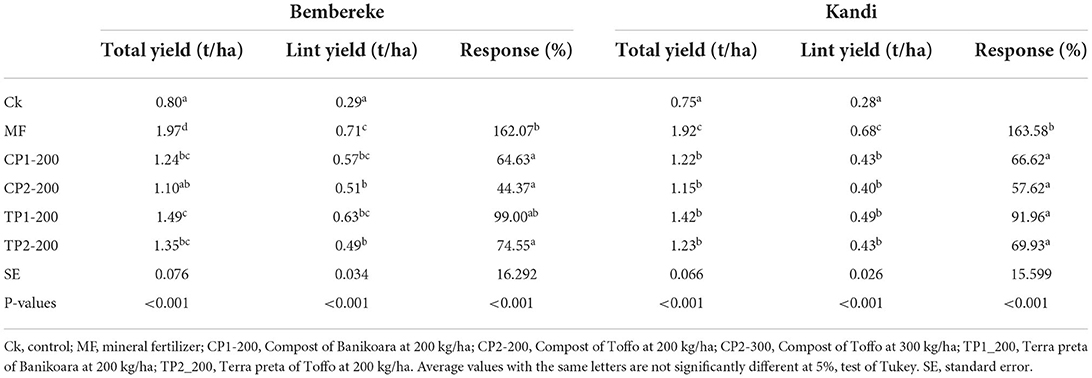
Table 6. Effect of biochar-based amendments on seed-cotton and lint yields at two on-farm experimental sites in northern Benin.
Economic indicators
Net return (NT) and gross margin (GM) were significanlty affected by the treatments (p < 0.001; Table 7) in Bembereke and Kandi. The MF treatment produced the highest NT and GM (573.73 and 554.86 USD/ha, and 684.25 and 665.38 USD/ha in Bembereke and Kandi, respectively). Among the organic fertilizers, the TP1_200 treatment produced the highest values for NT and GM (381.19 and 364.82 USD/ha, and 537.44 and 507.35 USD/ha in Bembereke and Kandi, respectively). The TP1_200 treatment produced BCR and VCR values most closed to the MF treatment at both sites.
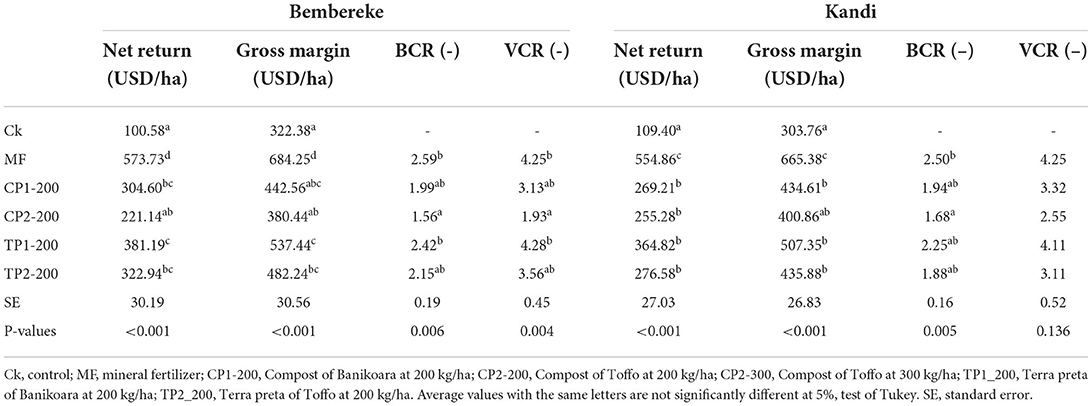
Table 7. Effect of biochar-based amendments on economic indicators at two on-farm experimental sites in northern Benin.
Analysis of environment stability and response to amendments
The stability analysis showed that TP1_200 performs well in all environments (Figure 4A). Treatments such as CP1_200, TP1_200 and TP2_200 have intermediate responses in all environments while mineral fertilizer (MF) treatment was more sensitive to improving environmental conditions. Nevertheless, it should be noted that the slope under the CP1_200 and CP2_200 treatments remain low, resulting in more stable yields. On the other hand, the slope under the MF treatment was strong which makes it more unstable.
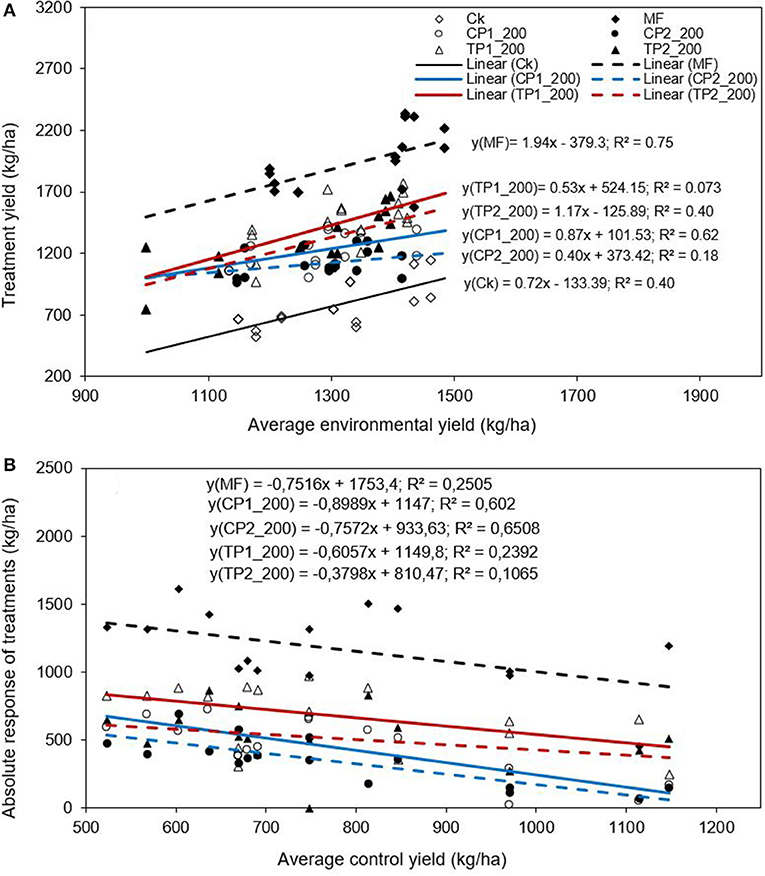
Figure 4. Stability analysis (A) and absolute response of different treatments as a function of the yield of the control plot (B). 4 The environmental average is the average yield of all treatments on a given agricultural site; Ck, control; MF, mineral fertilizer; CP1-200, Compost of Banikoara at 200 kg/ha; CP2-200, Compost of Toffo at 200 kg/ha; CP2-300, Compost of Toffo at 300 kg/ha; TP1_200, Terra preta of Banikoara at 200 kg/ha; TP2_200, Terra preta of Toffo at 200 kg/ha.
Figure 4B shows the absolute responses of the different treatments as a function of the yield of the control plot. Responses vary considerably from 461 to 1612 kg/ha, 29 to 721 kg/ha and 0 to 975 kg/ha, for MF, CP and TP treatments at both sites, respectively (Figure 4B). The yield response of different treatments tends to decrease with increased yields in control plots, with lesser decrease in TP treatments.
Discussion
Effect of treatments on cotton growth parameters
From this study, it appears that the different biochar-based treatments improved the growth of cotton with TP1 treatment producing better results at both on-station and on-farm trials. Compared to other treatments, the application of MF yielded best. This is explained by the solubility and availability of nutrients in MF that would have promoted the rapid growth of plants unlike the biochar and compost-based amendments (Kouassi et al., 2019). These results are similar to those obtained by Elangovan and Sekaran (2014) who showed that the increase in height of cotton plants was due to the balanced effect of the mineral fertilizer. The latter were able to show that biochar amendments increase total nitrogen by 7% and organic carbon by up to 69%. Using mass balance analysis, they observed no detectable loss of C from biochar during incubations, but recovered < 20% of C from manure. In addition, this difference in performance may also be due to the slow decomposition of biochar-based amendments after incorporation into the soil (Fischer and Glaser, 2012; Jien et al., 2015; Koulibaly et al., 2015).
Among the various biochar-based amendments, compost at 200 kg/ha and Terra preta at 200 kg/ha produced better growth preferences in on-station and on-farm conditions, respectively. Terra preta applied at 300 kg/ha was more productive in terms of the number of vegetative and fruiting branches and number of bolls. The stability that biochar confers on the compost contained in Terra preta justifies the advantage observed with Terra preta compared to sole compost and in particular with Terra preta of Banikoara (Fischer and Glaser, 2012; Jien et al., 2015; Zhang et al., 2020). The better performance of the Terra preta of Banikoara (TP1) compared to that of Toffo (TP2) could be explained by its richer chemical composition (Table 1) and by a possible fast decomposition process than TP2.
Effect of treatments on cotton yield and economic profitability
Regardless of the experimental conditions of each farm, we observed that yields increased by 96 and 73% on average, for the TP1 and TP2 treatments, respectively, compared to the control. The combination of compost and biochar (Terra preta) provides greater stability to soil nutrients and better water use for plants (Pandit et al., 2019). It is therefore understandable that the best performances demonstrated by Terra preta (TP1 and TP2) compared to the application of composts alone are related to the combined action of biochar and compost. Indeed, compost is a natural source of nutrients needed by plants for growth and productivity. Biochar is generally nutrient poor (Ding et al., 2016) but very porous in nature with a high specific surface area (Palansooriya et al., 2019), giving it a great potential to retain nutrients. According to Rees (2014), biochar controls nutrient mobility in soil-plant systems through a series of different mechanisms and on a practical level, it promotes phytostabilization and phytoextraction strategies of nutrients in soils. Several studies have reported the effect of compost combined with biochar (Terra preta) on plants. Rombel et al. (2022), noted that the application of biochar combined with compost, as the case of Terra preta in our study, is better than the separate application of biochar and compost, demonstrating the synergistic and beneficial effect of biochar mixed with compost. Although the nutrient content of Terra preta depends on the raw materials of the compost and biochar, the pyrolysis and the environmental conditions during the composting process (Antonangelo et al., 2021), the studies of Oldfield et al. (2018), confirmed that the mixed application of compost and biochar to the soil was beneficial to the crops with a lower negative environmental impact than the use of synthetic mineral fertilizers alone. According to Sánchez-Monedero et al. (2019), the mixed application of compost and biochar to the soil can not only serve as a substitute for synthetic mineral fertilizers, but it also stimulates microbial life in the soil, which in turn contributes to soil nutrient cycling. Several mechanisms have been suggested to explain the plant yield response to mixing biochar with a nutrient source. These include optimization of plant nutrient availability (Agegnehu et al., 2016), increased soil microbial biomass and activity (Wang et al., 2016), and most importantly the liming effect (Kätterer et al., 2019; Wang et al., 2019).
The differences in yields obtained between the fields at the station (Table 4) and at the farm (Table 6) can be explained by the texture of the soils at the sites, their initial level of fertility, and the rainfall. Indeed, the farmer's fields and station of Bembereke have the same soil texture (Loamy sand) with almost the same level of nitrogen, whereas the Parakou station has a sandytexture (Sandy loam) with a higher level of nitrogen. In addition, unlike the station of Parakou, there is low rainfall with an irregular distribution at Bembereke and Kandi. Sultan et al. (2010) and Anwar et al. (2020) also showed in their studies that cotton yield can vary greatly depending on rainfall and its distribution. Wang et al. (2019) reported that the effect of combining biochar with compost on plants is more noticeable on sandy soils or when there are drought spells during growing season. For example, Glaser et al. (2015) showed that combining biochar with compost increased maize yield by 26% over compost when grown on sandy soil. Similarly, Głab et al. (2018) found that the application of the compost-biochar mixture on sandy soils exhibited better water retention than the application of compost without biochar. Mekuria et al. (2014) showed that during a drought period, soils where the compost-biochar mixture was applied exhibited a smaller reduction in grain yield (35-36%) compared to soils that received only compost (40–64%). Furthermore, the initial soil fertility level influences the plant response to the compost-biochar mixture application (Wang et al., 2019).
The results of stability and response analysis showed a huge variability in yields between farms and within the same treatment (Figure 4B). Indeed, the treatment TP1_200 has been much more adapted and stable to the environment in which the trials were carried out. This could be due to its chemical composition which despite the poverty of the soils provides the necessary elements for the growth of cotton seedlings. Several authors have also observed a high variability in responses to organic and/or mineral fertilization for various crops and environments (Bielders and Gérard, 2015; Tovihoudji et al., 2019).
From an economic point of view, all treatments led to mean VCR values >2 (Tables 5, 7), which is generally considered as the lower threshold for adoption in smallholder, risk-averse farming systems. Hence all tested biochar-compost-based amendments may appear suitable for the conditions of northern Benin. Nevertheless, mean BCR and VCR values were notably higher for treatments involving CP1 (i.e CP1 and TP1) compared to those involving CP2. This is a direct consequence of the fact that CP1 and TP1 perform better than CP2 and TP2. Applying mineral fertilizer alone, though economically viable than the tested biochar-compost-based amendments, should not be suggested in the long-term. Continuous cultivation without organic amendment has been shown to lead to an increase of soil acidification and an overall decline in soil organic matter content and in the availability of other nutrients (Adams et al., 2016). Organic amendments are essential for sustaining soil quality in the long run. In addition to micronutrients supply, organic amendments are also essential to sustain soil life (Agegnehu et al., 2016). Hence, spot application of biochar-compost-based amendments (particularly TP1) appears to be an economically good alternative in the current agroecological transition pathway.
Conclusions
The results of the current study show that growth and yields of cotton can be significantly improved by biochar-compost-based amendments and ultimately farmers' livelihoods. From an economic pointview, TP1 treatment (at 200 or 300 ka/ha) appears interesting. Although higher agronomic and economic effects were observed for MF treatment, applying mineral fertilizer alone may prove unsustainable in the current context. Therefore, farmers should be encouraged to substitute mineral fertilizer by biochar-compost-based amendments by valuing the increased animal and crop wastes production as biochar and compost. However, actions have to be taken to provide farmers with more financial supports and training to produce biochar and compost. The results of stability and response analysis showed a variability in yields between farms and within the same treatment. The treatment TP1_200 was much more adapted and stable to various environments. However, further studies are needed across other agroecological zones in Benin and over several production seasons to better understand the agronomic response.
Data availability statement
The raw data supporting the conclusions of this article will be made available by the authors, without undue reservation.
Author contributions
GT and RD: conceptualization, methodology, and writing—review and editing. GT, WA, and FA: investigation, analysis, and writing—original draft. WA and TG: funding acquisition and review. All authors contributed to the article and approved the submitted version.
Funding
This research was funded by GiZ/One WORLD Without Hunger-SEWOH Soil Protection and Rehabilitation project to improve Food Security (ProSol).
Acknowledgments
We are grateful to faremers for their collaboration and to reviewers for their helpful comments, which strengthened the paper. Our sincere thanks to the GiZ/One WORLD Without Hunger-SEWOH Soil Protection and Rehabilitation project to improve Food Security (ProSol) for their financial and technical supports.
Conflict of interest
The authors declare that the research was conducted in the absence of any commercial or financial relationships that could be construed as a potential conflict of interest.
Publisher's note
All claims expressed in this article are solely those of the authors and do not necessarily represent those of their affiliated organizations, or those of the publisher, the editors and the reviewers. Any product that may be evaluated in this article, or claim that may be made by its manufacturer, is not guaranteed or endorsed by the publisher.
References
Adams, A. M., Gillespie, A. W., Kar, G., Koala, S., Ouattara, B., Kimaro, A. A., et al. (2016). Long-term effects of reduced fertilizer rates on millet yields and soil properties in the West-African Sahel. Nutr. Cycl. Agroecosyst. 106, 17–29. doi: 10.1007/s10705-016-9786-x
AFNOR (1987). “Qualité des Sols,” in Méthodes d'analyse. Recueil de normes françaises, Association française de normalisation, Paris (1987).
Agegnehu, G., Bass, A. M., Nelson, P. N., and Bird, M. I. (2016). Benefits of biochar, compost and biochar–compost for soil quality, maize yield and greenhouse gas emissions in a tropical agricultural soil. Sci. Total Environ. 543, 295–306. doi: 10.1016/j.scitotenv.2015.11.054
Ahmad, I., Saeed, U., Fahad, M., Ullah, A., Habib, R. M., Ahmad, A., et al. (2018). Yield forecasting of spring maize using remote sensing and crop modeling in Faisalabad-Punjab Pakistan. J Indian Soc. Rem. Sens. 46, 1701–1711. doi: 10.1007/s12524-018-0825-8
Akponikpe, P. B., Michels, K., and Bielders, C. L. (2008). Integrated nutrient management of pearl millet in the Sahel combining cattle manure, crop residue and mineral fertilizer. Exp. Agric. 44, 453–472. doi: 10.1017/S001447970800673X
Amanet, K., Chiamaka, E. O., Quansah, G. W., Mubeen, M., Farid, H. U., Akram, R., et al. (2019). “Cotton production in Africa,” in Cotton Production, eds Khawar Jabran and Bhagirath Singh Chauhan, 359–369.
Antonangelo, J. A., Sun, X., and Zhang, H. (2021). The roles of co-composted biochar (COMBI) in improving soil quality, crop productivity, and toxic metal amelioration. J. Environ. Manage. 277, 111443. doi: 10.1016/j.jenvman.2020.111443
Anwar, M. R., Wang, B., Liu, L. i, and Waters, D. (2020). Late planting has great potential to mitigate the effects of future climate change on Australian rain-fed cotton. Sci. Total Environ. 714, 136806.
Bationo, A., Kihara, J., and Adesina, A. (2012). “Beyond biophysical recommendations: towards a new paradigm,” in Improving Soil Fertility Recommendations in Africa Using the Decision Support System for Agrotechnology Transfer (DSSAT), eds J. Kihara, D. Fatondji, J. W. Jones, G. Hoogenboom, R. Tabo, A. Bationo. Springer, Dordrecht, The Netherlands, 169–184.
Bationo, A., Kihara, J., Vanlauwe, B., Waswa, B., and Kimetu, J. (2007). Soil organic carbon dynamics, functions and management in West African agro-ecosystems. Agric. Syst. 94, 13–25. doi: 10.1016/j.agsy.2005.08.011
Bielders, C. L., and Gérard, B. (2015). Millet response to microdose fertilization in south–western Niger: Effect of antecedent fertility management and environmental factors. Field Crops Res. 171, 165–175. doi: 10.1016/j.fcr.2014.10.008
Blanchard, M., Coulibaly, K., Bognini, S., Dugu,é, P., and Vall, E. (2014). Diversité de la qualité des engrais organiques produits par les paysans d'Afrique de l'Ouest: quelles conséquences sur les recommandations de fumure? Biotechnol. Agron. Soc. Environ. 18, 512–523.
Chen, L., Li, X., Peng, Y., Xiang, P., Zhou, Y., Yao, B., et al. (2022). Co-application of biochar and organic fertilizer promotes the yield and quality of red pitaya (Hylocereus polyrhizus) by improving soil properties. Chemosphere 294, 133619. doi: 10.1016/j.chemosphere.2022.133619
Cornelissen, G., Martinsen, V., Shitumbanuma, V., Alling, V., Breedveld, G. D., Rutherford, D. W., et al. (2013). Biochar effect on maize yield and soil characteristics in five conservation farming sites in Zambia. Agronomy 3, 256–274. doi: 10.3390/agronomy3020256
Ding, Y., Liu, Y., Liu, S., Li, Z., Tan, X., Huang, X., et al. (2016). Biochar to improve soil fertility. A review. Agron. Sustain. Dev. 36, 1–18. doi: 10.1007/s13593-016-0372-z
Elangovan, R., and Sekaran, N. C. (2014). Effect of biochar application on growth, yield and soil fertility status in cotton. Asian J. Soil Sci. 9, 41–49.
El-Naggar, A., Lee, S. S., Rinklebe, J., Farooq, M., Song, H., Sarmah, A. K., et al. (2019). Biochar application to low fertility soils: a review of current status, and future prospects. Geoderma 337, 536–554. doi: 10.1016/j.geoderma.2018.09.034
Fischer, D., and Glaser, B. (2012). Synergisms between compost and biochar for sustainable soil amelioration. Manage. Organic Waste 1, 167–199. doi: 10.5772/31200
Głab, T., Zabiński, A., Sadowska, U., Gondek, K., Kopeć, M., Mierzwa–Hersztek, M., et al. (2018). Effects of co-composted maize, sewage sludge, and biochar mixtures on hydrological and physical qualities of sandy soil. Geoderma 315, 27–35. doi: 10.1016/j.geoderma.2017.11.034
Glaser, B., Wiedner, K., Seelig, S., Schmidt, H. P., and Gerber, H. (2015). Biochar organic fertilizers from natural resources as substitute for mineral fertilizers. Agron. Sustain. Dev. 35, 667–678. doi: 10.1007/s13593-014-0251-4
Guertal, E. A., Raun, W. R., Westerman, R. L., and Boman, R. K. (1994). Applications of stability analysis for single-site, long-term experiments. Agron. J. 86, 1016–1019. doi: 10.2134/agronj1994.00021962008600060016x
Houba, V. J. G., Van Der Lee, J. J., and Novozamsky, I. (1995). Soil Analysis Procedures, other Procedures. Soil Plant Anal. part 5B, Syllabus 1995.
Ibrahim, A., Abaidoo, R. C., Fatondji, D., and Opoku, A. (2015). Hill placement of manure and fertilizer micro-dosing improves yield and water use efficiency in the Sahelian low input millet-based cropping system. Field Crops Res. 180, 29–36. doi: 10.1016/j.fcr.2015.04.022
Igué, A. M., Oussou, C. T. B., Sedegnan, O. C. A., and Kanninkpo, C. (2017). Etat de fertilité des sols et systèmes d'exploitation dans les communes de bembèrèkè, sinendé et kalalé dans le département du Borgou. Giz/ProSol, 14–178
Jeffery, S., Abalos, D., Prodana, M., Bastos, A. C., Van Groenigen, J. W., Hungate, B. A., et al. (2017). Biochar boosts tropical but not temperate crop yields. Environ. Res. Lett. 12, 053001. doi: 10.1088/1748-9326/aa67bd
Jien, S. H., Wang, C. C., Lee, C. H., and Lee, T. Y. (2015). Stabilization of organic matter by biochar application in compost-amended soils with contrasting pH values and textures. Sustainability 7, 13317–13333. doi: 10.3390/su71013317
Kätterer, T., Roobroeck, D., Andrén, O., Kimutai, G., Karltun, E., Kirchmann, H., et al. (2019). Biochar addition persistently increased soil fertility and yields in maize-soybean rotations over 10 years in sub-humid regions of Kenya. Field Crops Res. 235, 18–26. doi: 10.1016/j.fcr.2019.02.015
Kihara, J., Huising, J., Nziguheba, G., Waswa, B. S., Njoroge, S., Kabambe, V., et al. (2015). Maize response to macronutrients and potential for profitability in sub-Saharan Africa. Nutr. Cycl. Agroecosyst. 105, 171–181. doi: 10.1007/s10705-015-9717-2
Kouassi, Y. F., Gbogouri, G. A., N'guessan, K. A., Bilgo Pascal Angui, A. K. T, and Ama, T. J. (2019). Effets de fertilisants organique et organomineral a base de déchets végétaux et animaux sur la croissance et le rendement du soja (glycine max (l.) merrill) en zone de savane de côte d'ivoire. Agronomie Africaine 31, 1–12.
Koulibaly, B., Dakuo, D., Ouattara, A., Traor,é, O., Lompo, F., Zombr,é, P. N., et al. (2015). Effets de l'association du compost et de la fumure minérale sur la productivité d'un système de culture à base de cotonnier et de maïs au Burkina Faso. Tropicultura 33, 125–134.
Lal, R. (2009). Soil degradation as a reason for inadequate human nutrition. Food Secur. 1, 45–57. doi: 10.1007/s12571-009-0009-z
Lehmann, J. (2009). “Terra preta Nova–where to from here?,” in Amazonian Dark Earths: Wim Sombroek's Vision. Springer, Dordrecht, 473–486
Mekuria, W., Noble, A., Sengtaheuanghoung, O., Hoanh, C. T., Bossio, D., Sipaseuth, N., et al. (2014). Organic and clay-based soil amendments increase maize yield, total nutrient uptake, and soil properties in Lao PDR. Agroecol. Sustain. Food Syst. 38, 936–961. doi: 10.1080/21683565.2014.917144
Montaigne, W., Debon, H., Domenach, A. M., and Roggy, J. C. (2018). Gestion durable de la fertilité des sols par l'utilisation de matières organiques: retours d'expérience en Guyane française. Innovations Agronomiques 64, 71–82.
Nacro, S., Ouedraog,o, S., Traore, K., Sankara, E., Kabore, C., and Ouattara, B. (2010). Effets comparés des pratiques paysannes et des bonnes pratiques agricoles de gestion de la fertilité des sols sur les propriétés des sols et les rendements des cultures dans la zone sud soudanienne du Burkina Faso. Int. J. Biol. Chem. Sci. 4, 1044–1055. doi: 10.4314/ijbcs.v4i4.63042
Narzari, R., Bordoloi, N., Chutia, R. S., Borkotoki, B., Gogoi, N., Bora, A., et al. (2015). Biochar: an overview on its production, properties and potential benefits. Biol. Biotechnol. Sustain. Dev. 1, 13–40.
Nasim, W., Amin, A., Fahad, S., Awais, M., Khan, N., Mubeen, M., et al. (2018). Future risk assessment by estimating historical heat wave trends with projected heat accumulation using SimCLIM climate model in Pakistan. Atmos. Res. 205, 118–133. doi: 10.1016/j.atmosres.2018.01.009
Nyami, B. L., Sudi, C. K., and Lejoly, J. (2016). Effet du biochar et des feuilles de Tithonia diversifolia combiné à l'engrais minéral sur la culture du maïs (Zea mays L.) et les propriétés d'un sol ferralitique à Kinshasa (RDC). Biotechnol. Agron. Soc. Environ. 20, 57–67.
Oldfield, T. L., Sikirica, N., Mondini, C., López, G., Kuikman, P. J., and Holden, N. M. (2018). Biochar, compost and biochar-compost blend as options to recover nutrients and sequester carbon. J. Environ. Manage. 218, 465–476. doi: 10.25518/1780-4507.12592
Palansooriya, K. N., Wong, J. T. F., Hashimoto, Y., Huang, L., Rinklebe, J., Chang, S. X., et al. (2019). Response of microbial communities to biochar-amended soils: a critical review. Biochar 1, 3–22. doi: 10.1007/s42773-019-00009-2
Pandit, N. R., Schmidt, H. P., Mulder, J., Hale, S. E., Husson, O., Cornelissen, G., et al. (2019). Nutrient effect of various composting methods with and without biochar on soil fertility and maize growth. Arch. Agron. Soil Sci. 66, 250–265. doi: 10.1080/03650340.2019.1610168
Rees, F. (2014). Mobilité des métaux dans les systèmes sol-plante-biochar. Sciences agricoles. Université de Lorraine, Français. ffNNT : 2014LORR0293ff. fftel-01751380f
Rombel, A., Krasucka, P., and Oleszczuk, P. (2022). Sustainable biochar-based soil fertilizers and amendments as a new trend in biochar research. Sci. Total Environ. 816, 151588. doi: 10.1016/j.scitotenv.2021.151588
Rosenzweig, C., Elliott, J., Deryng, D., Ruane, A. C., Müller, C., Arneth, et al. (2014). Assessing agricultural risks of climate change in the 21st century in a global gridded crop model intercomparison. Proc Natl Acad Sci. 111, 3268–3273. doi: 10.1073/pnas.1222463110
Rutigliano, F. A., Romano, M., Marzaioli, R., Baglivo, I., Baronti, S., Miglietta, F., et al. (2014). Effect of biochar addition on soil microbial community in a wheat crop. Eur. J. Soil Biol. 60, 9–15. doi: 10.1016/j.ejsobi.2013.10.007
Sánchez-Monedero, M. A., Cayuela, M. L., Sánchez-García, M., Vandecasteele, B., D'Hose, T., López, G., et al. (2019). Agronomic evaluation of biochar, compost and biochar-blended compost across different cropping systems: Perspective from the European project FERTIPLUS. Agronomy 9, 225. doi: 10.3390/agronomy9050225
Soumaré, M., Havard, M., and Bachelier, B. (2021). Cotton in West and Central Africa: from the agricultural revolution to the agro-ecological transition. Cahiers Agricultures 30, 5. doi: 10.1051/cagri/2020044
Steiner, C., Bellwood-Howard, I., Häring, V., Tonkudor, K., Addai, F., Atiah, K., et al. (2018). Participatory trials of on-farm biochar production and use in Tamale, Ghana. Agron. Sustain. Dev. 38, 1–10. doi: 10.1007/s13593-017-0486-y
Sultan, B., Bella-Medjo, M., Berg, A., Quirion, P., and Janicot, S. (2010). Multi-scales and multi-sites analyses of the role of rainfall in cotton yields in West Africa. Int. J. Climatol. J. Royal Meteorol. Soc. 30, 58–71. doi: 10.1002/joc.1872
Tovihoudji, P. G., Akponikp,è, P. B. I., Adjogboto, A., Djenontin, J. A., Agbossou, E. K., and Bielders, C. L. (2017). Combining hill-placed manure and mineral fertilizer enhances maize productivity and profitability in northern Benin. Nutr. Cycl. Agroecosyst. 110, 375–393. doi: 10.1007/s10705-017-9872-8
Tovihoudji, P. G., Akponikp,è, P. I., Agbossou, E. K., and Bielders, C. L. (2019). Variability in maize yield and profitability following hill-placement of reduced mineral fertilizer and manure rates under smallholder farm conditions in northern Benin. Field Crops Res. 230, 139–150. doi: 10.1016/j.fcr.2018.10.018
Vanlauwe, B., Wendt, J., Giller, K. E., Corbeels, M., Gerard, B., Nolte, C., et al. (2014). A fourth principle is required to define conservation agriculture in sub-Saharan Africa: the appropriate use of fertilizer to enhance crop productivity. Field Crops Res. 155, 10–13. doi: 10.1016/j.fcr.2013.10.002
Walkley, A., and Black, I. A. (1934). An examination of Degtjareff method for determining soil organic matter and a proposed modification of the chromic acid titration method. Soil Sci. 29–37. doi: 10.1097/00010694-193401000-00003
Wang, J., Xiong, Z., and Kuzyakov, Y. (2016). Biochar stability in soil: meta-analysis of decomposition and priming effects. Gcb Bioener. 8, 512–523. doi: 10.1111/gcbb.12266
Wang, Y., Villamil, M. B., Davidson, P. C., and Akdeniz, N. (2019). A quantitative understanding of the role of co-composted biochar in plant growth using meta-analysis. Sci. Total Environ. 685, 741–752. doi: 10.1016/j.scitotenv.2019.06.244
Yeboah, E., Asamoah, G., Kofi, B., and Abunyewa, A. A. (2016). Effect of biochar type and rate of application on maize yield indices and water use efficiency on an Ultisol in Ghana. Energy Procedia 93, 14–18. doi: 10.1016/j.egypro.2016.07.143
Keywords: agroecology, biochar, innovation, Terra preta, northern Benin
Citation: Tovihoudji GP, Diogo RVC, Abiola AW, Akoha BRMF and Godau T (2022) Profitability and agronomic potential of cotton (Gossypium hirsutum L.) under biochar-compost-based amendments in three agroecological zones of northern Benin. Front. Sustain. Food Syst. 6:1036133. doi: 10.3389/fsufs.2022.1036133
Received: 04 September 2022; Accepted: 06 October 2022;
Published: 28 October 2022.
Edited by:
Cosmas Parwada, Zimbabwe Open University, ZimbabweReviewed by:
Angamuthu Manikandan, Indian Agricultural Research Institute (ICAR), IndiaAdnan Akhter, University of the Punjab, Pakistan
Lamy Hamed, Cairo University, Egypt
Copyright © 2022 Tovihoudji, Diogo, Abiola, Akoha and Godau. This is an open-access article distributed under the terms of the Creative Commons Attribution License (CC BY). The use, distribution or reproduction in other forums is permitted, provided the original author(s) and the copyright owner(s) are credited and that the original publication in this journal is cited, in accordance with accepted academic practice. No use, distribution or reproduction is permitted which does not comply with these terms.
*Correspondence: G. Pierre Tovihoudji, pierretovihoudji@yahoo.fr
 G. Pierre Tovihoudji
G. Pierre Tovihoudji